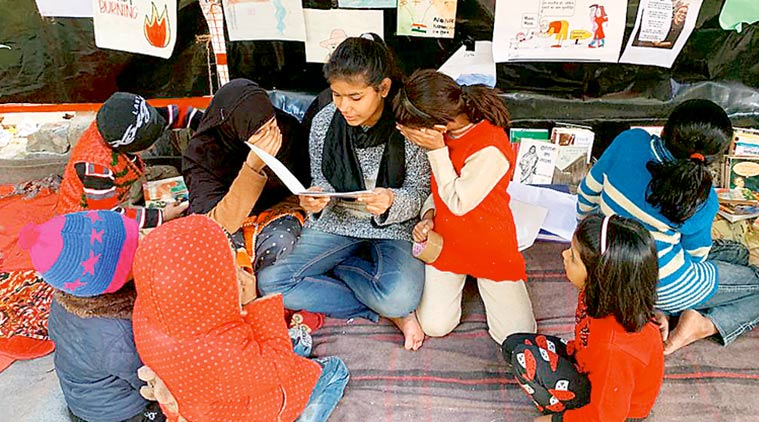 The readers: An open library at Hauz Rani in Delhi. (Source: Sushant Singh)
The readers: An open library at Hauz Rani in Delhi. (Source: Sushant Singh)
Eight weeks into the numerous sit-in protests across India against the new citizenship law and the proposed National Register of Citizens (NRC), the one striking feature is the proliferation of public libraries and reading rooms at these sites. Although this is a first for India, such public libraries have been a feature of many Occupy protests globally.
In 2011, the Occupy Wall Street protest in New York City’s Zuccotti Park erected a library, as did many other Occupy sites around the world. Hong Kong’s democracy protesters set up a library, as did the Plaza del Sol protests in Madrid and the Gezi Park protests in Turkey. In these protests in India, libraries have come up at various places in cities as diverse as Delhi, Nagpur, Kolkata, Sikar, Araria and Kanpur.
The first public library in these protests came up after Delhi Police stormed the Dr Zakir Husain library in Delhi’s Jamia Millia Islamia on December 15. The “Read for Revolution” library came up on a pavement adjoining the university, started by two current students, Anzar Rahi and Zeeshan Ramiz, and a former student, Mohammad Sahil. “The idea came when our library was assaulted by the police. Also, in a similar period of great turmoil during Partition, our university was started. We can’t start something on that scale but we can certainly start a library,” says Rahi.
Unlike a kitchen or a hospital, libraries do not seem like a necessity in the middle of protests that may be targeted by the police, but they are often among the first things started by protesters. Why is that so? “When people protest because of their great distrust of traditional institutions and electoral politics, as often happens today, their choice of participatory and anti-authoritarian methods of organising is not an afterthought. Instead, the environments that demonstrators are fashioning are a major part of what makes participation in protest worthwhile. Viewed through this lens, setting up libraries amid the tear gas makes perfect sense. Libraries express a set of values that are aligned with the deeply held values of the protesters,” answers Zeynep Tufekci of the University of North Carolina in her book, Twitter and Tear Gas: The Power and Fragility of Networked Protest (2017).
“The heart of protest is the well-being of the community, and the heart of a library is the empowerment books offer. This started as a constitutional protest, a claiming back of the republic, and books/protest libraries return a measure of power to the people,” says writer and author Nilanjana Roy.
“If police forces saw students reading as a threat, to fill protest areas with people hungry for knowledge, armed with books, was a befitting response. I have seen people spend long hours here reading these books,” says Surekha Pillai, a PR professional, who has been informally helping out the library on a regular basis. “Arundhati Roy came and gifted us 21 of her books. Other scholars, authors and writers have also visited or called us and sent books to us,” says Rahi. The library on the sidewalk has received more than 2,000 books, of which around 700 are kept in the library while the rest have been distributed to other similar libraries across India. It has inspired at least 18 libraries at sit-in protests all over India, he says.
One such library-cum-reading room has been running for two weeks at Kolkata’s main protest site in Park Circus Maidan. Another one came up in the city at Khidirpur’s Nawab Ali Park a week ago. The man who came up with the idea for the library at Park Circus is Reyaz Mohammad, head of the department of journalism and mass communication at Aliah University. “The protests had gone on for over a month and people like us had stayed on the fringe. Giving the idea of a reading room allowed us to intellectually engage with the people,” says Mohammad.
The most famous library in Delhi is at a bus stop shelter in Shaheen Bagh but even at the rather cramped Gandhi Park in Hauz Rani, a library draws the young and the old. On a Sunday afternoon, young children lounge around, reading children’s books. Priyanka, a data analyst who volunteers at the Hauz Rani library, says, “We started it on January 25, three days after the protests started. It is used both by children and adults. We have around 50-60 children who do drawing between 2 pm and 3 pm and then reading sessions between 3 pm and 5 pm. We are soon starting tuitions for the children to help them as their exams are around the corner.”
At the Shaheen Bagh library, only women are allowed to borrow books, while men can use the reading room. It is a place always full of people, reading in bright sunlight or makeshift lamps hanging from electric cables. They read the Indian Constitution in various languages, or books as varied as the poetry of Faiz Ahmed Faiz and Ramachandra Guha’s India After Gandhi (2007) but the most popular book there is undoubtedly journalist Ravish Kumar’s Bolna Hee Hai (2019).
What happens to these libraries when protests get over? Occupy Wall Street had a library containing more than 5,000 volumes, including books, magazines, and newspapers. The police destroyed it during the eviction of the group’s occupation, and the city was later ordered to pay hundreds of thousands of dollars in restitution. Rahi hopes for a better future for his library: “After the protest, it would be wonderful if we can make a public library of this.” “It’s a great sign that those who set up libraries to meet one kind of urgent need are now dreaming of creating more permanent residential libraries beyond the protest sites,” says Roy.